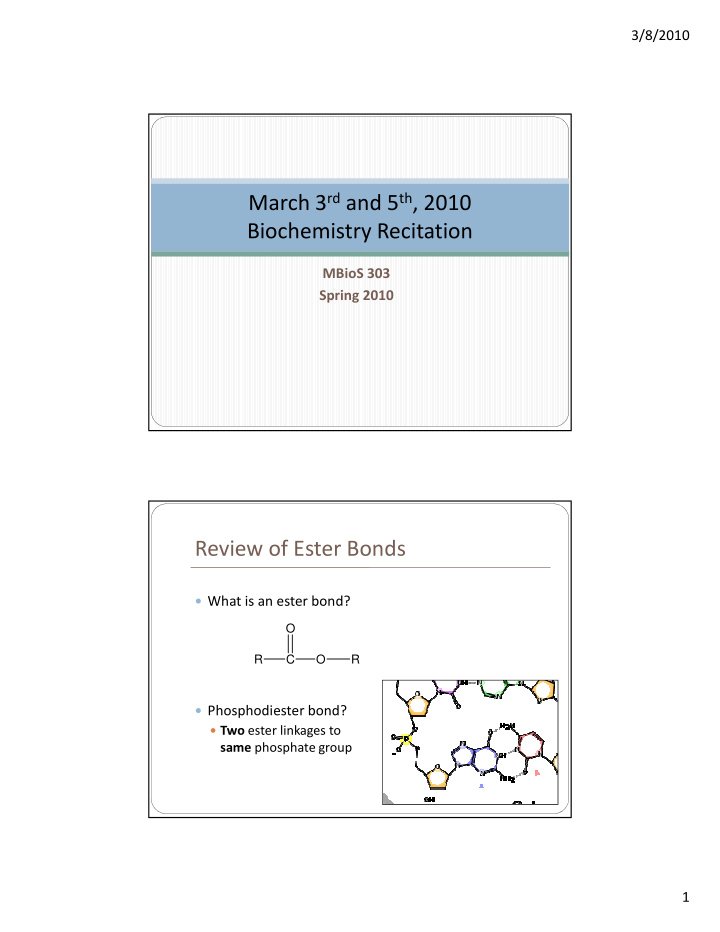



3/8/2010 March 3 rd and 5 th , 2010 Biochemistry Recitation MBioS 303 Spring 2010 Review of Ester Bonds � What is an ester bond? O R C O R � Phosphodiester bond? � Two ester linkages to same phosphate group 1
3/8/2010 Review of Ester Bonds � What is a phosphoanhydride bond? � High-energy bond between two phosphate groups γ β α γ β α γ β α γ β α QUIZ 4 2
3/8/2010 Outline � DNA Base Pairing and T m � Structural Features (palindromes, hairpins, etc.) � DNA Damage � DNA Supercoiling � DNA Sequencing � Higher Order DNA Structure (Chromatin) DNA Base Pairing and T m Biochemistry, 5 th Ed. What DNA bases typically pair with each other? 3
3/8/2010 DNA Base Pairing and T m How would you define T m ? Molecular Cell Biology, W.H. Freeman & Co., 1999 DNA/RNA Structural Features 4
3/8/2010 DNA Structural Forms A-DNA: More compact than B; found in dessicated forms B-DNA: Structure typically found in cells. KNOW the above characteristics! Z-DNA: More stretched than B; the only left-handed form. DNA Structural Forms A B C A B C Which pictures represent A, B and Z DNA? Genomes, 2 nd Ed. 5
3/8/2010 DNA Structural Forms: Palindromes � Both strands have the same sequence, in antiparallel orientation Examples: GAATTC ACCTAGGT CTTAAG TGGATCCA GACTCC XXXXXX GGAGTC See example on board CTGAGG XXXXXX CCTCAG http://en.wikipedia.org/wiki/Image:Stem-loop.svg Landes Bioscience, Eurekah.com Mirror Repeats � The same sequence is present on one strand, as a mirror image � Can’t form hairpins 6
3/8/2010 Mirror Repeats � The same sequence is present on one strand, as a mirror image � Can’t form hairpins � CAN form DNA triple helices � Functional importance: produces sharp bend in DNA Landes Bioscience, Eurekah.com DNA Damage 7
3/8/2010 Who Cares? � Damaged RNA and proteins can be easily replaced by reading from the DNA sequence � There is no way to replace the DNA molecules! � Unrepaired DNA mutations linked to disease, including cancer � Unrepaired mutations may be passed to offspring if occur in gametes � Cells have a number of DNA repair systems to fix such mutations Sources of Damage � Endogenous cellular sources � Reactive Oxygen Species (ex. from electron transport chain) � Base hydrolysis (ex. deamination, depuriniation, etc.) � Base mismatch (from errors in DNA replication) � Exogenous sources of damage � UV light � Ionizing radiation � Chemical sources (may cause many types of DNA damage) 8
3/8/2010 Depurination � Hydrolysis of N- glycosidic bond linking sugar and purine base � Occurs spontaneously in the cell � Up to 10,000 purines lost from DNA every 24 hours in a mammalian cell What kind of problem could this cause in a cell? Why? The Cell: A Molecular Approach, 2 nd Ed. Deamination � Loss of exocyclic amino groups � Occurs spontaneously in the cell � About 100 deaminations occur in a mammalian cell every day � May explain why DNA contains T rather than U The Cell: A Molecular Approach, 2 nd Ed. 9
3/8/2010 UV Induced DNA Damage: CPDs � Cross-linking between C5 and C6 on adjacent pyrimidine bases (usually thymine) forming a ring structure = cyclobutane pyrimidine dimer (CPD) UV light Molecular Cell Biology, W.H. Freeman & Co., 1999 UV Induced DNA Damage: CPDs � Causes “kink” in DNA � Dimer can’t fit normally into double helix, blocking replication and gene expression until removed http://home.twcny.rr.com/geomanagement/ensmingr/menagerie.html 10
3/8/2010 UV Induced DNA Damage: 6-4 PP � Cross-linking between C6 on one pyrimidine to C4 on an adjacent pyrimidine = 6-4 photoproduct � Occur less frequently than CPDs, but are more damaging � Cause bigger “kink” in DNA, which tends to be lethal rather than mutagenic Modern Genetic Analysis DNA Damage: Summary Deamination Depurination Cyclobutyl 6-4 pyrimidine photo- dimers products Cause Spontaneous Spontaneous UV light UV light Result Loss of exocyclic Loss of purine Formation of Formation of 6- amine group base cyclobutyl ring 4 crosslink that structure; can causes block significant kink replication and in DNA gene expression backbone; can block replication/ gene expression 11
3/8/2010 DNA Supercoiling Supercoiling � Coiling a coil � Intrinsic property of DNA 12
3/8/2010 Linking Number � Lk = number of times one strand passes through the “plane” created by the other strand Change in Linking Number � For B-DNA, Linking number ( Lk ) = (# base pairs)/10.5 � More base pairs per turn (ex. 12 instead of 10.5) = - Lk � Fewer base pairs per turn (ex. 9 instead of 10.5) = + Lk 13
3/8/2010 Effect of Fixed DNA Ends Molecular Biology of the Cell, 4 th Ed. Function of Topoisomerases? Molecular Biology of the Cell, 4 th Ed. 14
3/8/2010 Topoisomerase I Molecular Cell Biology, 4 th Ed. � Releases strain from over- or under-winding of the DNA � Forms a single-stranded break, and changes linking number by 1 � ATP independent Topoisomerase II (ex. DNA Gyrase) Molecular Cell Biology, 4 th Ed. � Releases strain from underwinding of the DNA � Forms a double-stranded break, and changes linking number by 2 � ATP dependent 15
3/8/2010 Comparison of Topoisomerases Topoisomerase I Topoisomerase II Mechanism single-strand break double-strand break Change in Lk 1 2 Reliance on ATP ATP independent ATP dependent 16
Recommend
More recommend